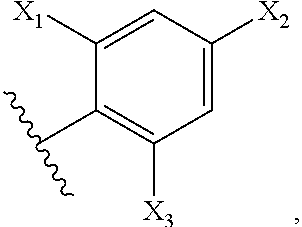Methods for Modulating Bacterial Virulence and Related Compounds
a bacterial virulence and virulence technology, applied in the field of bacteria and infectious diseases, can solve the problems of interfere with the ability of bacteria, etc., and achieve the effects of inhibiting bacterial virulence, low evolutionary pressure for bacteria to evolve resistance mechanisms to this type of treatment, and broad applicability
- Summary
- Abstract
- Description
- Claims
- Application Information
AI Technical Summary
Benefits of technology
Problems solved by technology
Method used
Image
Examples
example 1
Screening for Inhibitors of Bacterial Virulence
[0208]A library of 150,000 small organic molecules from UT Southwestern Medical Center, Dallas, Tex., was screened at 5 μM in a high throughput assay to identify inhibitors of QseC-dependent virulence gene activation in EHEC. The first round of positive “hits,” represented a diverse range of molecular architecture, was subjected to additional rounds of screening followed by preliminary evaluations for toxicity against bacterial cells in vitro. This yielded a pool of 75 potential inhibitors with IC50 values at or below 10−5 M.
[0209]In EHEC, the genes involved in the formation of the AE lesion are encoded within a chromosomal pathogenicity island named the Locus of Enterocyte Effacement (LEE). The LEE region contains five major operons: LEE1, LEE2, LEE3, LEE4 and LEE5, which encode a type III secretion system (TTSS), an adhesin (intimin), and this adhesin's receptor (Tir), which is translocated to the epithelial cell through the bacterial...
example 2
Preparation of Certain Compounds of the Present Invention
[0212]General Procedure A.
[0213]To an oven dried flask containing amine (1 mmol), acid chloride (1 equiv), and N,N-dimethylaminopyridine (DMAP, 1.2 equiv) was added CH2Cl2 (10 mL). The reaction was continued overnight, then quenched with the addition of water (5 mL) and extracted 3 times with CH2Cl2. The combined extracts were dried over Na2SO4, filtered and concentrated under vacuum. The residue was purified on preparative TLC to give the desired amide.
[0214]General Procedure B.
[0215]To an oven dried flask containing amine (1.2 equiv), carboxylic acid (1 mmol), EDCI (1.2 equiv), HOBt (1.2 equiv) and N,N-diisopropylethylamine
[0216](DIPEA, 1.2 equiv) was added DMF (10 mL). The reaction was continued overnight. After completion by TLC, the reaction was quenched with water (5 mL) and extracted 3 times with EtOAc, dried over Na2SO4, filtered and concentrated under vacuum. The crude product was purified on prep-TLC to give the desi...
example 3
Quantitative Real-Time (RT)-PCR
[0227]Quantitative real-time (RT)-PCR was used in a variety of the following Examples, and the general protocol is as follows. Overnight cultures grown aerobically in LB for Salmonella typhimurium, DMEM for EHEC (WT and qseC mutant found in Sperandio et al., 2002, which is incorporated herein by reference) and Mueller Hinton for F. tularensis at 37° C. to either mid-exponential growth phase (OD600 0.5) or late-exponential growth phase (OD600 1.0). For the epinephrine studies, a stock epinephrine solution of 50 mM in water was made and diluted 10−3 in overnight cultures that were diluted 1:100 in DMEM for a final concentration of 50 μM. RNA from three biological replicate cultures of each strain was extracted using the RiboPure™—Bacteria RNA isolation kit (Ambion) following manufacturer's guidelines. The primers used in the Real-Time assays were designed using Primer Express v1.5 (Applied Biosystems) (Table 2). Real-Time RT-PCR was performed in a one-st...
PUM
| Property | Measurement | Unit |
|---|---|---|
| temperatures | aaaaa | aaaaa |
| time | aaaaa | aaaaa |
| time | aaaaa | aaaaa |
Abstract
Description
Claims
Application Information
 Login to View More
Login to View More - R&D
- Intellectual Property
- Life Sciences
- Materials
- Tech Scout
- Unparalleled Data Quality
- Higher Quality Content
- 60% Fewer Hallucinations
Browse by: Latest US Patents, China's latest patents, Technical Efficacy Thesaurus, Application Domain, Technology Topic, Popular Technical Reports.
© 2025 PatSnap. All rights reserved.Legal|Privacy policy|Modern Slavery Act Transparency Statement|Sitemap|About US| Contact US: help@patsnap.com



